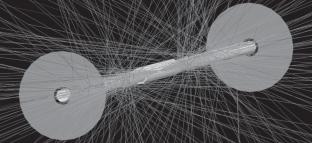束管对确定Au-Au相互作用坐标精度影响的评价
IF 0.4
4区 物理与天体物理
Q4 PHYSICS, NUCLEAR
引用次数: 0
摘要
考虑了在质心能量为7 GeV时Au-Au相互作用坐标的确定问题以及不同离子束管构型对结果的影响。使用UrQMD 3.4事件生成器Geant4和神经网络模型进行建模。研究了八种配置:离子束管的壁厚分别为1.2、3、5和8mm,壁材分别为碳和铁。使用管壁厚度为1 ~ 3 mm的梁管对结果影响不显著,但进一步增加管壁厚度会显著降低精度。本文章由计算机程序翻译,如有差异,请以英文原文为准。

Evaluation of the Influence of the Beam Pipe on the Accuracy of Solving the Problem of Determining the Coordinates of Au–Au Interactions
The problem of determining the coordinates of Au–Au interactions at a center-of-mass energy of 7 GeV and the influence of different ion beam pipe configurations on the results are considered. The modeling was performed using the UrQMD 3.4 event generator, Geant4, and a neural network model. Eight configurations were studied: ion beam pipes with wall thicknesses of 1.2, 3, 5, and 8 mm, with the wall material being carbon and iron. The use of beam pipe with walls with thicknesses of 1–3 mm does not significantly affect the outcome, but further increasing the wall thickness significantly reduces accuracy.
求助全文
通过发布文献求助,成功后即可免费获取论文全文。
去求助
来源期刊

Physics of Atomic Nuclei
物理-物理:核物理
CiteScore
0.60
自引率
25.00%
发文量
56
审稿时长
3-6 weeks
期刊介绍:
Physics of Atomic Nuclei is a journal that covers experimental and theoretical studies of nuclear physics: nuclear structure, spectra, and properties; radiation, fission, and nuclear reactions induced by photons, leptons, hadrons, and nuclei; fundamental interactions and symmetries; hadrons (with light, strange, charm, and bottom quarks); particle collisions at high and superhigh energies; gauge and unified quantum field theories, quark models, supersymmetry and supergravity, astrophysics and cosmology.
 求助内容:
求助内容: 应助结果提醒方式:
应助结果提醒方式:


